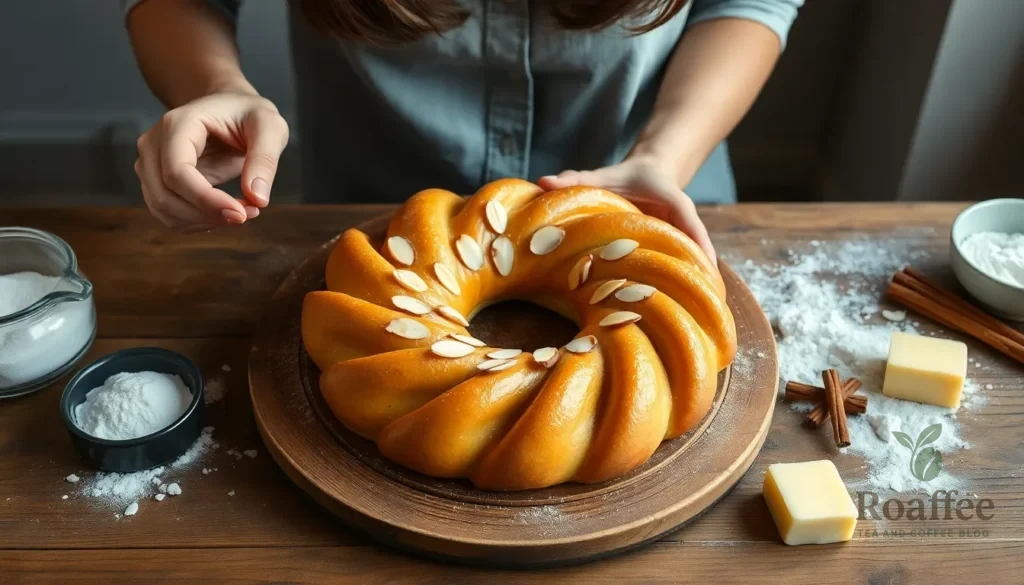Nothing captures the essence of Swedish baking quite like a beautifully braided tea ring filled with warm spices and sweet surprises. This traditional Scandinavian pastry transforms any ordinary morning into something truly special with its golden, buttery layers and aromatic cinnamon-sugar filling.
We’ve perfected this Swedish tea ring recipe to bring you all the authentic flavors without the intimidation factor. The soft, pillowy dough practically melts in your mouth while the sweet filling creates pockets of pure indulgence in every bite. It’s the kind of bread that makes your kitchen smell like a cozy European bakery.
What makes this recipe truly shine is its versatility – you can customize the filling with your favorite nuts, dried fruits, or even a cream cheese swirl. Whether you’re hosting a weekend brunch or simply treating yourself to something homemade, this Swedish tea ring delivers that perfect balance of comfort and elegance we all crave.
Ingredients
We’ve carefully selected each ingredient to create the perfect balance of flavors and textures in our Swedish tea ring. These simple pantry staples come together to form a tender dough, aromatic filling, and glossy glaze.
For the Dough
- 3 cups all-purpose flour
- 1 packet (2¼ teaspoons) active dry yeast
- ¼ cup granulated sugar
- 1 teaspoon salt
- ½ cup whole milk, warmed to 110°F
- ¼ cup unsalted butter, melted
- 1 large egg, room temperature
- 1 teaspoon vanilla extract
For the Filling
- ¼ cup unsalted butter, softened
- ⅓ cup brown sugar, packed
- 2 teaspoons ground cinnamon
- ¼ teaspoon ground cardamom
- ¼ cup chopped almonds or pecans (optional)
- 2 tablespoons all-purpose flour
For the Glaze
- 1 cup powdered sugar, sifted
- 3-4 tablespoons whole milk
- ½ teaspoon vanilla extract
- Pinch of salt
- Sliced almonds for garnish (optional)
Equipment Needed
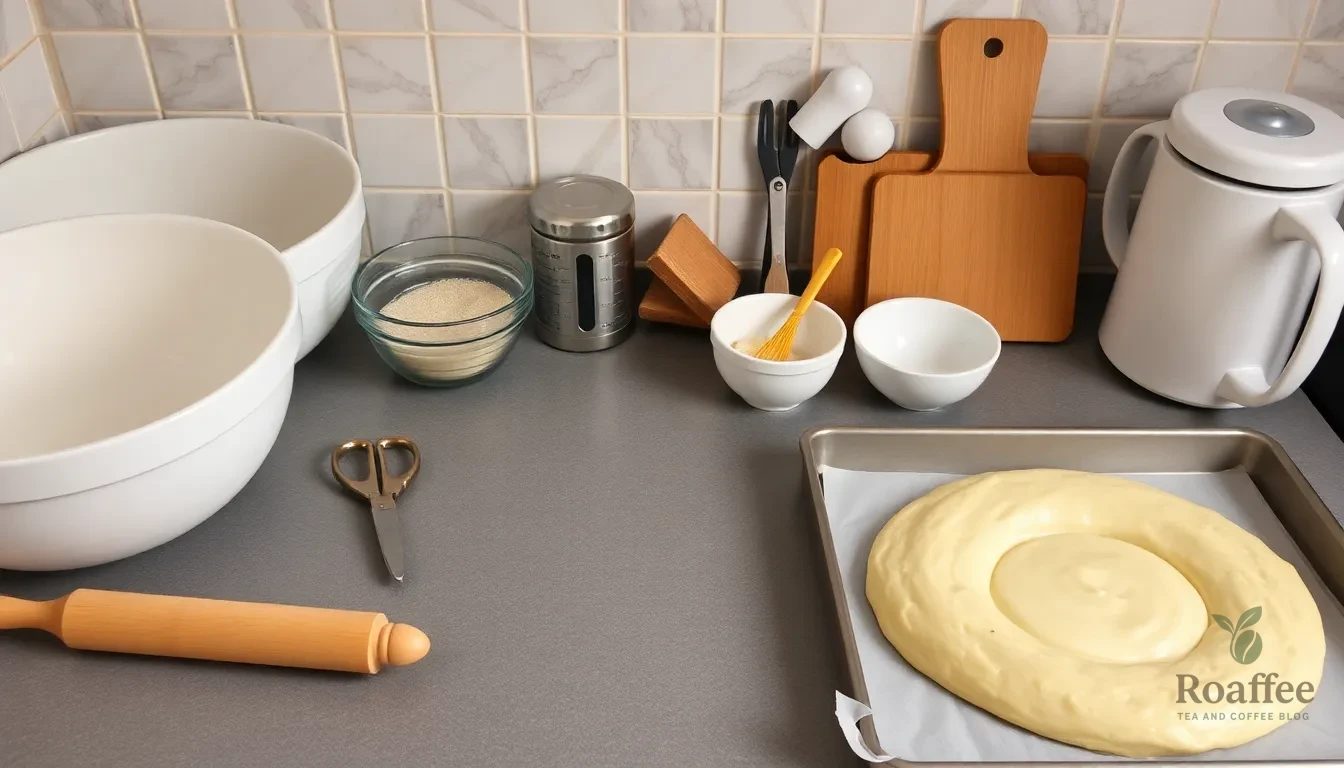
Creating the perfect Swedish tea ring requires exact tools that ensure our dough rises beautifully and shapes into that signature braided ring. We recommend gathering these essential items before beginning our baking journey.
Large Mixing Bowls form the foundation of our preparation process. We need at least two bowls – one for mixing the dough and another for preparing our filling ingredients. Stainless steel or glass bowls work best as they maintain consistent temperatures during the rising process.
Measuring Tools guarantee accuracy in our recipe execution. We suggest using both measuring cups and spoons alongside a kitchen scale. Weighing flour ensures better dough consistency, which proves especially important for achieving the tender, enriched texture that makes Swedish tea rings exceptional.
Rolling Pin transforms our risen dough into the perfect rectangle for filling and shaping. A traditional wooden rolling pin or silicone version both work effectively for creating an even thickness throughout our dough.
Kitchen Scissors or Sharp Knife become essential for the distinctive cutting and twisting technique that creates the tea ring’s beautiful spiral pattern. Sharp kitchen scissors often provide more control when cutting through the filled dough roll.
Baking Surface requires either a half sheet baking pan or round cake pan, depending on your preferred presentation style. We recommend lining your chosen pan with a silicone baking mat or parchment paper to prevent sticking and ensure easy removal.
Small Bowl for Glaze allows us to mix our powdered sugar glaze to the perfect consistency. A whisk or fork helps achieve the smooth, drizzle-ready texture that crowns our finished tea ring.
These tools work together to create the ideal environment for crafting an authentic Swedish tea ring that rivals traditional bakery versions.
Instructions
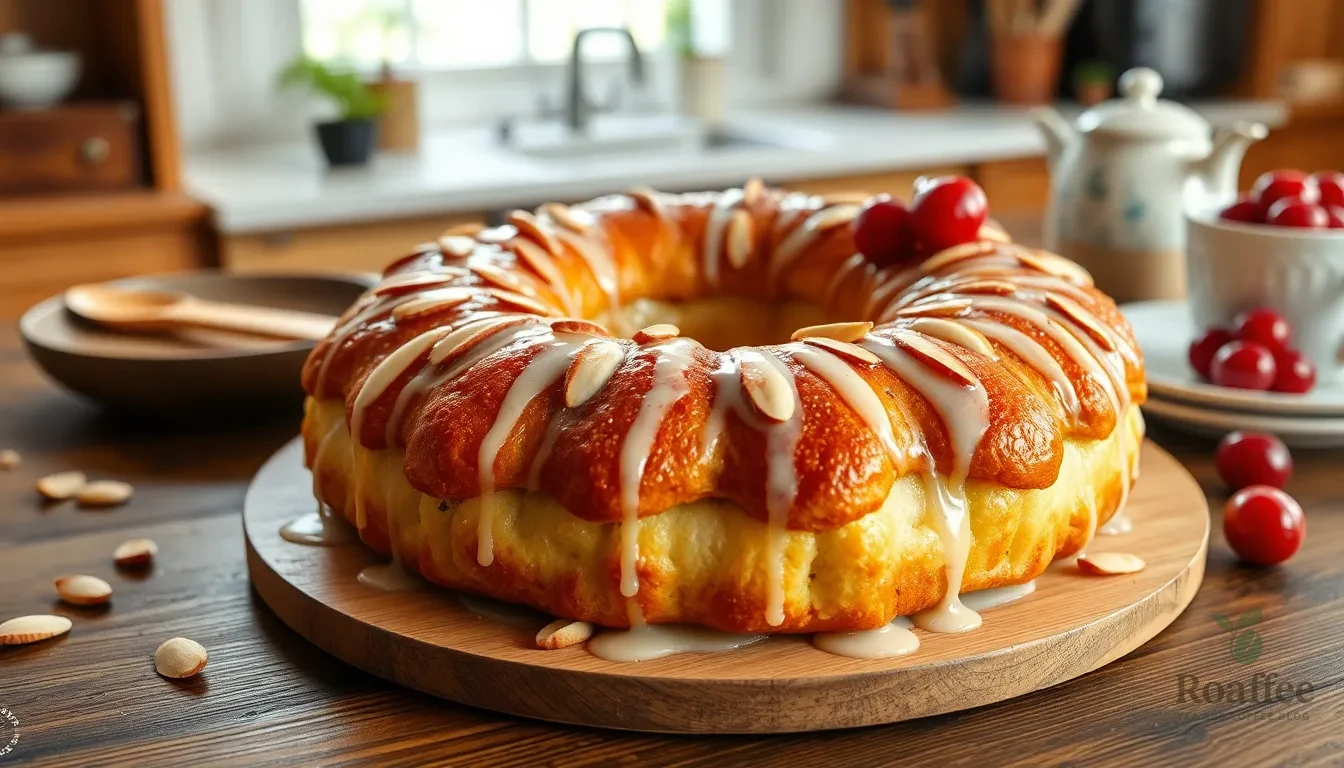
Now we move to the heart of our Swedish tea ring recipe where careful attention to each step ensures our traditional pastry turns out perfectly. Following these detailed instructions will guide us through creating the signature spiral shape and achieving that golden, aromatic result.
Prep the Dough
We begin by proofing 2¼ teaspoons of active dry yeast in ¼ cup of lukewarm water for about 5 minutes until it becomes foamy. Next, we combine ¾ cup of lukewarm milk, ¾ cup of sugar, 1 teaspoon of salt, 1 egg, and our softened butter with the yeast mixture in our large mixing bowl. We gradually stir in flour until we achieve a smooth but slightly sticky dough that pulls away from the sides of the bowl.
Using the heel of our hand, we knead the dough on a lightly floured surface for 4-5 minutes until it becomes smooth and elastic. We place the kneaded dough in a well-oiled bowl, turning it once to coat all sides. Covering the bowl with a damp towel, we let the dough rise in a warm spot for approximately 1½ hours until it doubles in size. After the first rise, we gently deflate the dough by pressing it down with our fist to release the air bubbles.
Make the Filling
We roll our risen dough into a rectangle measuring about 15 x 9 inches on a lightly floured surface. Using a pastry brush or our fingers, we spread softened butter evenly over the entire surface of the dough, leaving a small border around the edges. We combine our brown sugar, ground cinnamon, ground cardamom, and chopped nuts in a small bowl, mixing thoroughly to distribute the spices evenly.
Sprinkling this aromatic mixture over the buttered dough, we press it gently into the surface to ensure it adheres well. For added flavor depth, we can incorporate a teaspoon of lemon zest into our filling mixture, which complements the cardamom beautifully. The raisins get scattered over the spiced mixture, creating pockets of sweetness throughout our tea ring.
Roll and Shape the Tea Ring
Starting from the long side, we roll the dough tightly like a jelly roll, keeping the filling secure inside. We pinch the seam firmly to seal it and trim any uneven ends with a sharp knife. Carefully, we form the rolled dough into a circle shape on our prepared baking sheet, placing the seam side down.
Using kitchen scissors, we make cuts at 1-inch intervals around the ring, cutting about two-thirds of the way through but not completely. We twist or rotate each slice gently outward to reveal the beautiful spiral filling pattern. This technique creates the signature appearance that makes our Swedish tea ring so visually appealing. We cover the shaped ring with a clean kitchen towel and let it rise for 35-40 minutes until it doubles in size again.
Let Rise and Bake
We preheat our oven to 375°F (190°C) while the tea ring completes its final rise. Once the dough has doubled and springs back slowly when gently touched, we place it in the preheated oven. We bake for 20-30 minutes until the top becomes golden brown and the internal temperature reaches 190°F when tested with a thermometer.
If our tea ring browns too quickly during baking, we cover it loosely with aluminum foil to prevent over-browning while allowing the interior to finish cooking. The finished tea ring should sound hollow when tapped on the bottom. We remove it from the oven and let it cool on the baking sheet for 5-10 minutes before glazing.
Prepare the Glaze
While our tea ring is still warm, we prepare the glaze by whisking together powdered sugar, whole milk, vanilla extract, and a pinch of salt in a small bowl until smooth. We adjust the consistency by adding more milk for a thinner glaze or more powdered sugar for a thicker coating. Using a spoon or pastry brush, we drizzle the glaze over the warm tea ring, allowing it to flow into the crevices between the twisted sections.
For an authentic Swedish touch, we sprinkle sliced almonds over the glazed surface while it’s still wet so they adhere properly. Some traditional recipes call for candied cherries as decoration, which we can place strategically around the ring for a festive appearance. The glaze will set as the tea ring cools, creating a beautiful finish that complements the rich, spiced interior.
Directions for Assembly
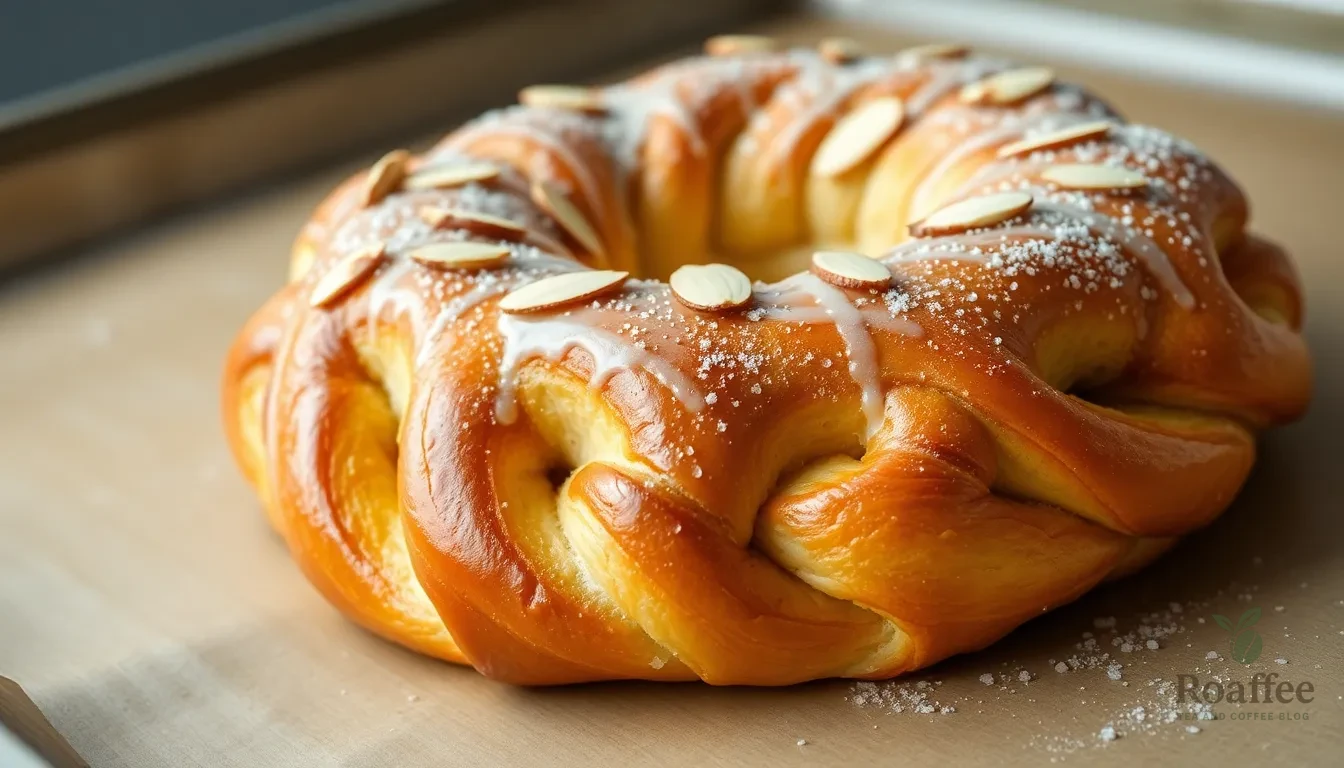
Now that we’ve prepared our dough and gathered our filling ingredients, we’re ready to transform our risen dough into the beautiful Swedish tea ring that makes this recipe so special. Let’s work through each step to create that signature twisted ring shape.
Rolling the Dough
We begin by punching down our risen dough and giving it a light kneading on a floured surface. Our goal is to roll the dough into a rectangle measuring approximately 15 x 9 inches with a thickness of about 1/2 inch. This size ensures we have enough surface area for our filling while maintaining the perfect dough-to-filling ratio. The dough should feel smooth and pliable as we work with it.
Adding the Filling
We spread our softened butter evenly across the entire surface of the rolled dough using a pastry brush or the back of a spoon. Next, we sprinkle our sugar and cinnamon mixture generously over the buttered surface. For added flavor complexity, we can include ground cardamom or lemon zest at this stage. Those who enjoy extra texture can add chopped pecans, pistachios, or raisins to create a more indulgent filling.
Shaping the Ring
Starting from the long edge, we roll the dough tightly into a jelly-roll style log, ensuring we maintain even pressure throughout. We pinch the seam closed to prevent the filling from escaping during baking. The rolled log then gets formed into a ring shape by bringing the ends together and pinching them securely. After placing our ring seam-side down on a prepared baking sheet, we use kitchen scissors to make 1-inch cuts around the entire circumference, cutting about two-thirds through the dough. Each cut section gets twisted or rotated to the side, exposing the beautiful spiral filling and creating the tea ring’s distinctive appearance.
Final Touches
Our shaped ring needs a second rise of 30-40 minutes until it doubles in size. During this time, we preheat our oven to 375°F (190°C). Before baking, we brush the surface with egg wash to achieve that golden, glossy finish. The tea ring bakes for 20-25 minutes until it reaches a beautiful golden brown color. Once cooled slightly, we apply our prepared glaze and garnish with sliced almonds, additional nuts, or candied cherries for that final festive touch.
Baking Tips

Temperature control plays a crucial role in creating the perfect Swedish tea ring. We recommend using a thermometer to ensure your milk reaches the ideal lukewarm temperature of 105-110°F before adding the yeast. Water that’s too hot will kill the yeast while liquid that’s too cool won’t activate it properly.
Testing your yeast before beginning the recipe saves time and prevents disappointment. Active dry yeast should foam and bubble within 5-10 minutes when combined with lukewarm liquid and a pinch of sugar. If your yeast doesn’t react this way replace it with fresh yeast before proceeding.
Flour measurement significantly impacts the final texture of your tea ring. We suggest using the spoon-and-level method rather than scooping directly from the bag which can pack too much flour into your measuring cup. The dough should feel slightly sticky but manageable when properly mixed.
Creating the perfect rise environment ensures your dough doubles in size within the expected timeframe. Place the covered bowl in a warm draft-free location such as on top of your refrigerator or in an oven with just the light turned on. Cold environments can extend rising time to 2-3 hours.
Rolling technique affects how evenly your filling distributes throughout the tea ring. Start from the center and work outward when rolling your dough into a rectangle. Apply gentle even pressure to maintain consistent thickness across the entire surface.
Sealing the edges properly prevents the filling from leaking during baking. Press the seam firmly with your fingertips or the side of your hand to create a tight seal. This step becomes especially important when shaping the ring and making the decorative cuts.
Timing your cuts correctly creates the signature twisted appearance that makes Swedish tea rings so visually appealing. Make your 1-inch interval cuts only after the ring has completed its second rise. Cutting too early can deflate the dough and result in uneven sections.
Oven positioning influences how evenly your tea ring bakes. Place the ring on the middle rack of your preheated 375°F oven for optimal heat circulation. Baking on the lower rack may cause the bottom to brown too quickly while the upper rack can over-brown the top.
Checking for doneness requires more than just visual cues. Your tea ring should sound hollow when tapped gently on the bottom and reach an internal temperature of 190°F. The golden brown color should appear even across the entire surface.
Cooling properly before glazing prevents the icing from melting and sliding off your beautiful creation. Allow the tea ring to cool on a wire rack for at least 15 minutes before applying the glaze. This brief waiting period ensures the glaze sets properly and creates an attractive finish.
Make-Ahead Instructions
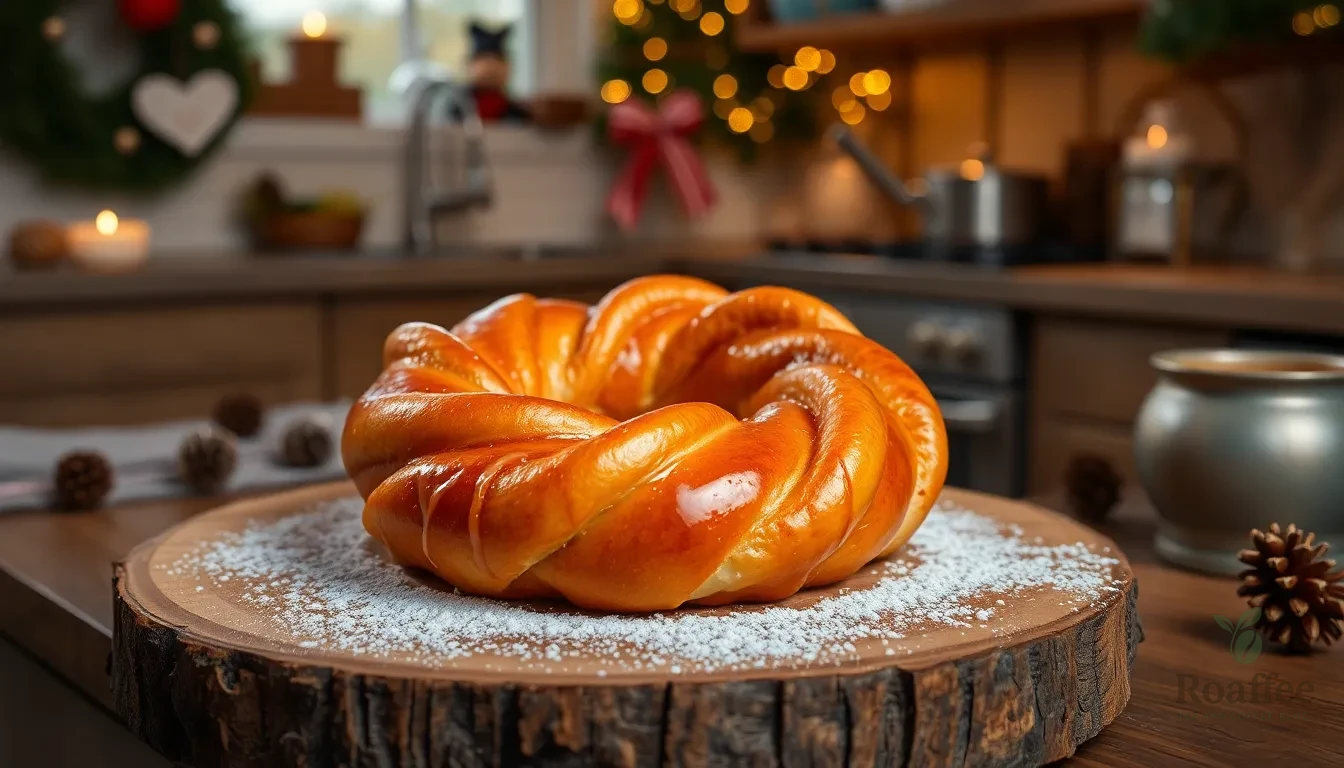
Swedish tea rings adapt beautifully to advance preparation, making them perfect for holiday mornings or special occasions when we want to minimize last-minute work. The dough rings can be prepared ahead, shaped, and frozen before baking, allowing us to thaw, rise, and bake fresh treats with minimal effort.
Freezing the Shaped Dough
We recommend preparing the tea ring completely through the shaping process, including the signature cuts and twists. Once shaped, wrap the unbaked ring tightly in plastic wrap and place it in a freezer-safe bag. The shaped dough freezes well for up to 3 months, maintaining its flavor and texture when properly stored.
Thawing and Final Rise
Remove the frozen tea ring from the freezer and place it on a parchment-lined baking sheet. Allow the dough to thaw at room temperature for approximately 2 hours, then cover with a clean kitchen towel and let it rise until doubled in size. This second rise typically takes 45 minutes to 1 hour, depending on room temperature.
Overnight Refrigerator Method
For next-day baking, we can shape the tea ring and place it in the refrigerator overnight instead of freezing. Cover the shaped ring with plastic wrap and refrigerate for up to 24 hours. Remove from the refrigerator 1 hour before baking to allow it to come to room temperature and complete its final rise.
Baking From Frozen Preparation
Once the thawed tea ring has completed its final rise, brush with egg wash and bake according to the original recipe instructions. The baking time remains the same at 350-375°F for 20-30 minutes until golden brown. Apply the glaze while warm and add decorative toppings as desired for a fresh-from-the-oven appearance.
Storage and Serving
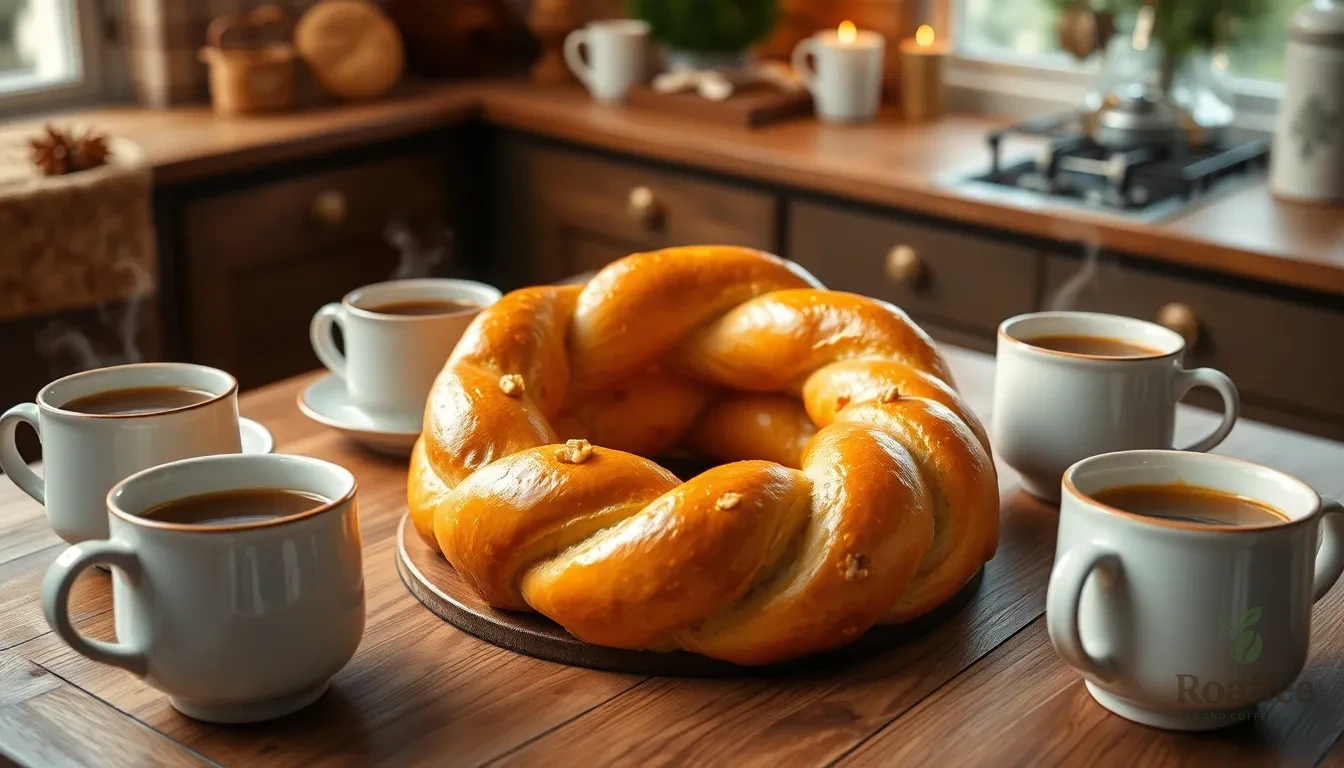
We recommend serving our Swedish tea ring fresh from the oven for the ultimate experience. The warm, aromatic pastry tastes best when enjoyed the same day we bake it. Our tea ring pairs beautifully with a hot cup of coffee or tea, making it perfect for holiday gatherings or cozy afternoon treats.
Optimal Storage Methods
We should store any leftover tea ring in an airtight container at room temperature. A cake dome works equally well to maintain freshness and prevent the glazed surface from drying out. Our properly stored tea ring maintains its quality for up to three days when kept in these conditions.
Refreshing Day-Old Tea Ring
We can revive day-old tea ring by warming it gently in a conventional oven at 300°F for about 10 minutes. A toaster oven works just as effectively for smaller portions. The glaze may melt slightly during reheating, so we should expect this natural occurrence when warming our stored tea ring.
Serving Suggestions
We love presenting our Swedish tea ring as a centerpiece for special occasions. The beautiful twisted shape and golden glaze make it an impressive addition to holiday breakfast tables or afternoon tea services. We can slice the ring into individual portions, allowing guests to appreciate the spiral layers and nutty filling throughout each piece.
Temperature Considerations
| Storage Method | Temperature | Duration |
|---|---|---|
| Room Temperature | 68-72°F | 1-3 days |
| Refrigerator | 35-40°F | 5-7 days |
| Reheating | 300°F | 10 minutes |
We find that serving our tea ring at room temperature provides the best texture and flavor balance. The butter in the dough and filling reaches its optimal consistency when not too cold, allowing the cardamom and cinnamon flavors to shine through each bite.
Conclusion
This Swedish tea ring recipe brings together the best of traditional Scandinavian baking with modern convenience. We’ve shown you how to create this stunning pastry that’s perfect for impressing guests or treating your family to something special.
The beauty of this recipe lies in its flexibility – you can make it ahead for busy mornings or customize the filling to match your preferences. Whether you’re serving it for a holiday breakfast or weekend brunch the results will always be impressive.
Now that you have all the techniques and tips at your fingertips there’s nothing stopping you from creating this bakery-quality treat in your own kitchen. The combination of buttery dough aromatic spices and sweet glaze makes every bite worth the effort.
Frequently Asked Questions
What is a Swedish tea ring?
A Swedish tea ring is a traditional Scandinavian pastry featuring a beautiful braided shape and aromatic cinnamon-sugar filling. Made with soft, buttery dough and often filled with nuts or dried fruits, it’s twisted into a signature spiral ring shape that creates an impressive centerpiece for special occasions or coffee breaks.
What ingredients do I need for a Swedish tea ring?
For the dough, you’ll need all-purpose flour, active dry yeast, granulated sugar, salt, warm whole milk, melted butter, egg, and vanilla extract. The filling requires softened butter, brown sugar, cinnamon, cardamom, optional nuts, and flour. The glaze uses powdered sugar, milk, vanilla, and salt.
Can I make Swedish tea ring ahead of time?
Yes! You can freeze the shaped dough for up to three months before baking. Alternatively, refrigerate the shaped ring overnight and bake the next day. Both methods require a final rise before baking. The baking time remains the same regardless of whether you use frozen or refrigerated dough.
How do I store leftover Swedish tea ring?
Store leftover tea ring in an airtight container at room temperature for up to three days. For best quality, serve day-old rings after gentle reheating in an oven or toaster oven. This helps revive the pastry’s flavor and texture while maintaining its buttery consistency.
What’s the key to shaping a Swedish tea ring properly?
Roll the risen dough into a rectangle, spread the butter and cinnamon mixture evenly, then roll into a log. Shape into a ring, seal the ends, and make cuts around the ring before twisting each section. Allow for a second rise before baking for the signature twisted appearance.
How do I know when my Swedish tea ring is done baking?
Look for a golden brown color and check the internal temperature, which should reach the proper doneness level. Position the ring in the center of the oven for even baking. The pastry should sound hollow when tapped and pull away slightly from the pan edges.
Can I customize the filling in my Swedish tea ring?
Absolutely! While the traditional filling includes cinnamon and cardamom, you can add chopped almonds, pecans, dried fruits, or even cream cheese. This versatility makes the recipe suitable for various tastes and special occasions while maintaining the classic Swedish tea ring structure.

